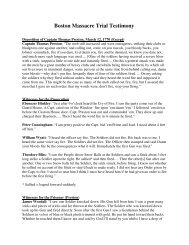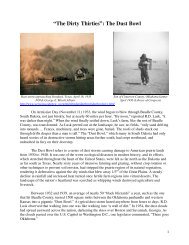Volume 1, Issue 1 - Teach American History
Volume 1, Issue 1 - Teach American History
Volume 1, Issue 1 - Teach American History
Create successful ePaper yourself
Turn your PDF publications into a flip-book with our unique Google optimized e-Paper software.
<strong>Volume</strong> 1, <strong>Issue</strong> 1<br />
Integrating NHD in Your Classroom (cont.)<br />
Making that integration work in that setting took great teamwork! Another high school spent one day a week in<br />
class. Most of their research had to be done out of class because the information was not accessible in the school’s<br />
library or on the Internet. Given plenty of time and deadlines, this is all workable.<br />
The most important ingredient to making this integration work is not only getting other teachers in the school to<br />
catch the NHD bug as well, but one must be willing to call for help from the many available sources in the surrounding<br />
community. The East Tennessee Historical Society is just a phone call away whether it be for presenting<br />
the topic to students, coaching students periodically along the way, having former NHD students and teachers<br />
come and present during workshops, and/or getting either a teacher, student, and/or parent in touch with valuable<br />
research resources. There are also valuable repositories containing rich primary and secondary source materials<br />
located in the numerous universities and special collection libraries in our region. NHD in East TN has grown by<br />
leaps and bounds this past year, and I am sure there is a NHD educator near all of us. Many educators are not used<br />
to calling on help from outside sources or do not know how to go about integrating a presentation into their already<br />
packed schedule. This is probably the simplest but most effective step for someone who is wondering how to integrate<br />
NHD in his or her classroom instruction. Once one gets over this, he/she will soon realize the truth in the<br />
NHD motto: It’s not just a day; it’s an experience. It is definitely a life-changing experience for all.<br />
Getting a Handle on the Website Category<br />
Page 31<br />
In 2007, NHD introduced the website category—the most interactive of all the current NHD categories. Since then,<br />
teachers, students, parents, and yes, even NHD coordinators, have all been scratching their heads trying to get a<br />
handle on the website category. At Knoxville, we have struggled with many questions and issues that develop naturally<br />
as a result of any new category being introduced into the program: What do the rules say about each and every<br />
aspect of the category? When is the appropriate deadline for websites so that they can be received and turned<br />
around to judges in a timely fashion? How do we give sufficient notice to ensure that all teachers, students, and<br />
parents realize that individual and group website projects are judged together rather than separately as in other categories?<br />
What do we do when students do not submit the website design in the proper format (i.e. website browser)?<br />
What do we do when students submit only 1 copy (or worse, none at all) of their Process Paper and annotated bibliography?<br />
What is the best way to showcase the websites at the district contest so that others can benefit from seeing<br />
what the other competitors are doing with their website?<br />
Experience has shown that in Tennessee (and I suspect across the nation) few students outside those who place 1st<br />
or 2nd have a real firm grasp on the category. Please be sure to read the NHD rules as they seem to be ever changing.<br />
The most up-to-date NHD rules can always be found on the NHD website (www.nhd.org). As with the 2009<br />
contest, website projects that arrive in our office in 2010 that do not meet Rules 1-9 of the NHD Rule Book (pg.<br />
21), will not be distributed to the judges. Therefore, if we receive 6 submissions and only 2 meet the full guidelines,<br />
then only those 2 will compete in Knoxville, despite the opportunity for a 3rd project to represent East Tennessee<br />
at the state contest. The most frequent violations of the rules involve Rules 7 and 9. Please be sure the project<br />
is viewable in a standard web browser and that 4 copies of the Process Paper and Annotated Bibliography are<br />
submitted. Also, as in each category, there is a limitation on student-composed words. If NHD states a maximum<br />
number—1200 for websites—be sure to use it! Lastly, I would strongly suggest students take advantage of Rule<br />
3—unlimited 45 second multimedia clips (yet be mindful of the 100MB file space allowed).<br />
NEW at East Tennessee <strong>History</strong> Day 2010<br />
Unfortunately, we do not have access to computers to permit public viewing of websites at the district contest;<br />
however, 1 or 2 “paper” copies of all Websites (and Papers), will be available at the registration desk for viewing—after<br />
all, in each and every other category, students can see the work of other students.






